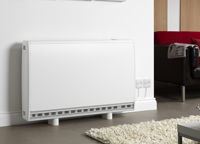Creda Heating is introducing an electric space heater like no other with Quantum, an electric heating system that’s up to 25 percent cheaper to run and uses up to 20 percent less energy than comparable static storage heaters.

Maintenance-free and with low installation costs, Quantum offers benefits to specifiers, end users, energy suppliers and installers alike, with real potential to help tackle fuel poverty and reduce carbon emissions.
Designed to access low carbon electricity from renewable sources such as solar PV and wind, Quantum stores this ‘green’ energy when it’s available, in the form of heat to use as and when required, for low cost, low carbon warmth.
The Quantum Energy System consists of the Quantum room heater, the Quantum hot water storage cylinder and the Quantum Hub, three elements that combine to achieve extremely high levels of energy efficiency in a whole-house system. It’s anticipated the Quantum room heater will meet up to 97 percent of heating requirements from off-peak energy, with fan-assisted output and boost element for a fast top-up if required. The cylinder offers class-leading heat retention for an economical hot water supply, while the hub uses an economical demand response management tool to enable ‘smart’ two-way communication.
The whole system is future-proofed to support upcoming changes in the way energy is supplied. Quantum appliances use the very latest insulation materials to prevent any heat being lost or wasted and also feature the latest ‘smart’ controls, able to adapt to weather and usage patterns to ensure precisely the right amount of heat is delivered when required. With Quantum’s advanced control comes user comfort. Thanks to its high level of heat retention, the Quantum room heater is able to closely match target room temperature throughout the day using heat from economical off-peak sources, typically with a warmer temperature required in the morning and evening, and a lower background temperature during the daytime and then overnight.
